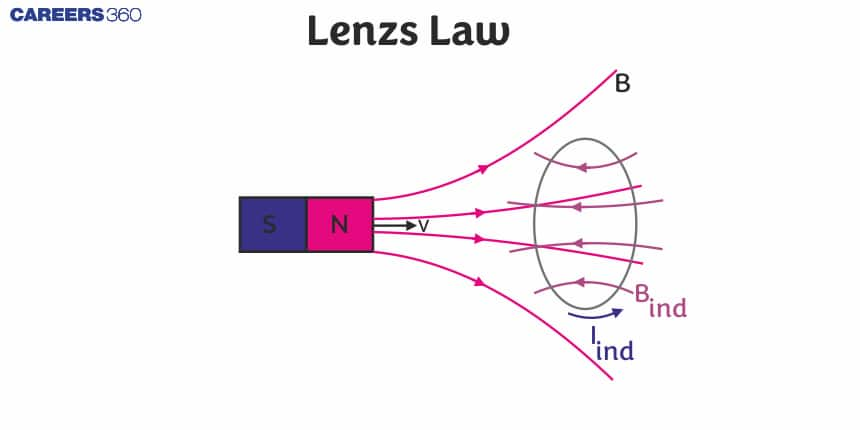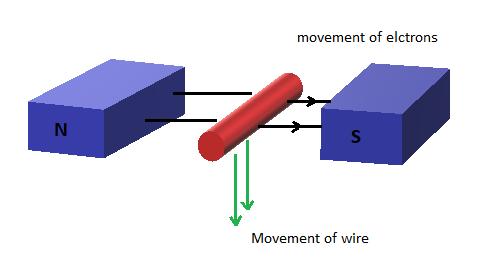Lenzs Law - Definition, Formula, Examples, Applications, FAQs
Lenz's Law was formulated by Emil Lenz in 1834. It describes that if a changing magnetic field produces a current in a conductor, the direction of the current is in such a way that it is in opposition to the resulting change in the magnetic field. Lenz's Law is derived from Faraday's Law of Electromagnetic Induction, according to which the emf (voltage) induced in a coil is a function of the rate of change of the magnetic field. Faraday's formula indicates this opposition by the negative sign. In this article, you will learn about Lenz’s Law, its formula, experiment, applications, and some important FAQs.
This Story also Contains
- What is Lenz law?
- Lenz law formula:
- Examples of Lenz’s Law
- Applications of Lenz law
- Experiment of Lenz law of electromagnetic induction:

Also read -
What is Lenz law?
Lenz’s Law states that the direction of the induced current is always such that it opposes the change in magnetic flux that produces it.
whenever a changing magnetic field induces a current in a conductor, the current creates its own magnetic field that tries to oppose the original change. This is a result of the law of conservation of energy, which ensures that no energy is lost or created without cause.
Lenz law formula:
The formula of Faraday's law is based on Lenz's law. Lenz law provides the negative sign in this case. It is given by the formula:
$
\mathrm{Emf}=-\mathrm{N}(\Delta \phi / \Delta \mathrm{t})
$
The induced voltage is referred to as Emf (also known as electromotive force).
- The number of loops is N .
- $\Delta \phi$ Change in magnetic flux
- $\Delta t$ is the passage of time.
The induced electromotive force and the rate of change in magnetic flux have the same sign, indicating that they are in opposing directions.
This indicates that the direction of an induced field's back EMF opposes the changing current that causes it. D.J. Griffiths summed it up this way: "Nature despises change."
It's a qualitative law that describes the direction of generated current but not the amplitude of it. Many electromagnetic phenomena, such as the direction of voltage induced in an inductor by changing current, or the drag force of eddy currents imparted on moving objects in a magnetic field, are predicted by Lenz law.
Examples of Lenz’s Law
Moving Magnet and Coil:
When a magnet is moved toward a coil, an induced current is produced in the coil. This current creates a magnetic field that opposes the motion of the magnet. When the magnet is moved away, the direction of the current reverses to oppose that motion too.
Falling Magnet through a Copper Tube:
When a magnet falls through a copper tube, eddy currents are induced in the tube. These currents produce a magnetic field that opposes the motion of the magnet, making it fall slowly.
Switching Off an Electromagnet:
When the current in an electromagnet is switched off, the decreasing magnetic field induces a current that tries to maintain the original magnetic field.
Electric Brakes in Trains:
In electric trains, eddy currents are produced in the metallic parts when the magnetic field changes. These currents oppose the motion of the wheels, helping the train to slow down.
|
Related Topics, |
Applications of Lenz law
Lenz has a plethora of legal uses. The following are a few of them:
- Balances of eddy currents
- Metal detectors are used to detect metal.
- Eddy current dynamometers.
- Train AC generators have braking systems.
- Readers of credit cards
- Microphones
Experiment of Lenz law of electromagnetic induction:
Lenz law is used to determine the direction of the induced electromotive force and current. In accordance with Lenz's theory, he performed some experiments.

First Experiment
He concluded in the first experiment that magnetic field lines are formed when electricity in the coil flows in the circuit. The magnetic flux will grow as the current flowing through the coil increases. When the magnetic flux increases, the flow of induced current will be in the opposite direction.
Second Experiment
In the second experiment, he discovered that an induced current is produced when the current-carrying coil is wound on an iron rod with its left end acting as an N-pole and advanced towards the coil S.
Third Experiment
In the third experiment, he discovered that when the coil is drawn towards the magnetic flux, the coil connected to it shrinks, implying that the coil's area within the magnetic field shrinks. When the induced current is delivered in the same direction as the coil's motion, Lenz's law states that the coil's motion is opposed.
The magnet in the loop exerts a force on the current to produce it. The current must exert a force on the magnet to counteract the change.
NCERT Physics Notes:
Also, check-
Frequently Asked Questions (FAQs)
Lenz law is based on the idea of energy conservation. The induced current is always resisted by the source that produces it, according to the definition of Lenz law. As a result, more effort is done against the opposing force. Work done against an opposing force causes a change in magnetic flux, which causes current to be produced. Electrical energy is the result of the extra labour done, and it is protected by the rule of conservation of energy.
Faraday's law is about the electromagnetic force created, whereas Lenz law is about energy conservation applied to electromagnetic induction.
The direction of the induced current is determined using Lenz law.
The induced emf in the coil is in the opposite direction of the magnetic flux that is coupled to the coil, as indicated by the negative sign in lenz law equation.
Electromagnetic circuits obey the conservation of energy and Newton's third law, according to Lenz law.